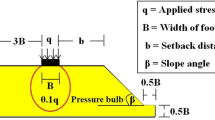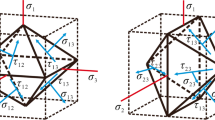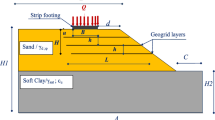Abstract
Finite element method can be used for computing bearing capacity of shallow foundation with irregular geometry resting on variable subsoil. It is necessary to quantify the parameters affecting the ultimate capacity of footing. This paper presents the results of finite element (FE) analysis of the ultimate failure load of a rough base rigid strip footing resting on c-ϕ soil. The soil is assumed as linear elastic perfectly plastic with Mohr–Coulomb failure criterion and non-associative flow rule. Sensitivity analysis is carried out to examine the ultimate capacity of strip footing considering the strength parameters (c′, ϕ′, and ψ), width of strip footing (B), unit weight of soil (γ), surcharge (q) at the base level of footing, and the deformation parameters (E and ν) as the variables. The study also examines the effect of different material models on the ultimate capacity of the strip footing. The material models considered are Mohr–Coulomb (MC) model, Hardening Soil (HS) model, Hardening Soil model with small-strain stiffness (HSsmall), and Soft Soil (SS) mode-l. It is found from the results of FE analysis that the ultimate load of the strip footing is dependent on the strength parameters, width of footing, unit weight of soil, and surcharge at the base level of the footing. The ultimate capacity is independent of the deformation parameters and will remain almost same corresponding to the material models like MC, HS, HSsmall, and SS. The FE results are compared with the analytical solutions of Terzaghi and Meyerhof. Based on the study, a few suggestions are given in regard to the FE analysis of geotechnical stability problems to obtain the quick results.








Similar content being viewed by others
References
Bolton MD, Lau CK (1993) Vertical bearing capacity factors for circular and strip footings on Mohr–Coulomb soil. Can Geotech J 30(6):1024–1033
Brinkgreve RBJ, Vermeer PA, Bakker KJ (1988) Material model manual, PLAXIS V.7, A.A. Balkema, Rotterdam, Brookfield
Chakraborty D (2016) Bearing capacity of strip footings by incorporating a non-associated flow rule in lower bound limit analysis. Int J Geotech Eng 10(3):311–315
Chandrashekhara K, Antony SJ, Mondal D (1998) Semi-analytical finite element analysis of a strip footing on an elastic reinforced soil. Appl Math Model 22(4–5):331–349
Chen WF (1975) Limit analysis and soil plasticity. Elsevier, Amsterdam
Drucker DC, Greenberg HJ, Prager W (1951) The safety factor of an elastic–plastic body in plane strain. J Appl Mech ASME 18:371–378
Drucker DC, Prager W, Greenberg HJ (1952) Extended limit design theorems for continuous media. Q Appl Math 9(4):381–389
Frydman S, Burd HJ (1997) Numerical studies of the bearing capacity factor Nγ. J Geotech Eng 123(1):20–29
Griffiths DV (1982) Computation of bearing capacity factors using finite elements. Géotechnique 32(3):195–202
Griffiths DV (1989) Computation of collapse loads in geomechanics by finite elements. Arch Appl Math 59(3):237–244
Hansen JB (1961) A general formula for bearing capacity. B Geoteknisk Institut, B 11, The Danish Geotech Inst, Copenhagen
Hjiaj M, Lyamin AV, Sloan SW (2004) Bearing capacity of a cohesive-frictional soil under non-eccentric inclined loading. Comput Geotech 31(6):491–516
Kumar J (2004) Effect of footing—soil interface friction on bearing capacity factor Nγ. Géotechnique 54(10):677–680
Kumar J (2009) The variation of Nγ with footing roughness using the method of characteristics. Int J Num Anal Methods Geomech 33(2):275–284
Kumar J, Khatri V (2008) Effect of footing roughness on lower bound Nγ values. Int J Geomech ASCE 8(3):176–187
Kumar J, Kouzer KM (2007) Effect of footing roughness on bearing capacity factor Nγ. J Geotech Geoenviron Eng ASCE 133(5):502–511
Maheshwari P, Madhav MR (2006) Analysis of a rigid footing lying on three-layered soil using the finite difference method. Geotech Geol Eng 24(4):851–869
Meyerhof GG (1957) The ultimate bearing capacity of foundations on slopes. In: proc 4th int conf soil mech found eng, London, 1: 384–386
Meyerhof GG (1963) Some recent research on the bearing capacity of foundations. Can Geotech J 1(1):16–26
Michalowski RL (1997) An estimate of the influence of soil weight on bearing capacity using limit analysis. Soils Found 37(4):57–64
Murray EJ, Geddes JD (1989) Resistance of passive inclined anchors in cohesionless medium. Geotechnique 39(3):417–431
Sahoo JP, Kumar J (2015) Ultimate bearing capacity of shallow strip and circular foundations by using limit analysis, finite elements, and optimization. Int J Geotech Eng 9(1):30–41
Schanz T, Vermeer PA, Bonnier PG (1999) The hardening-soil model: formulation and verification. In: Brinkgreve RBJ (ed) Beyond 2000 in computational geotechnics. Balkema, Rotterdam, pp 281–296
Sloan SW (1988) Lower bound limit analysis using finite-elements and linear programming. Int J Num Anal Methods Geomech 12(1):61–77
Soubra AH (1999) Upper-bound solutions for bearing capacity of foundations. J Geotech Geoenviron Eng ASCE 125(1):59–68
Terzaghi K (1943) Theoretical soil mechanics. Wiley, New York
Ukritchon B, Whittle AJ, Klangvijit C (2003) Calculation of bearing capacity factor Nγ using numerical limit analyses. J Geotech Geoenviron Eng ASCE 129(5):468–474
Veiskarami M, Kumar J, Valikhah F (2014) Effect of the flow rule on the bearing capacity of strip foundations on sand by the upper-bound limit analysis and slip lines. Int J Geomech ASCE 14(3):04014008
Yin J, Wang Y, Selvadurai A (2001) Influence of nonassociativity on the bearing capacity of a strip footing. J Geotech Geoenviron Eng ASCE 127(11):985–989
Ziccarelli M, Valore C, Muscolino SR, Fioravante V (2017) Centrifuge tests on strip footings on sand with a weak layer. Geotech Res 4(1):47–64
Zienkiewicz OC, Humpheson C, Lewis RW (1975) Associated and nonassociated visco-plasticity and plasticity in soil mechanics. Géotechnique 25(4):671–689
Author information
Authors and Affiliations
Corresponding author
Appendix 1
Appendix 1
Mohr–Coulomb model In Mohr–Coulomb (MC) model, the yield function consists of principal stresses and strength parameters of the soil, c′ and ϕ′ [2]. In the principal stress space, the Mohr–Coulomb failure envelope represents a straight line at the intersection with an octahedral plane. It is shown to provide a good fit to the experimental data in triaxial compression and extension. The Mohr–Coulomb material model can be used most conveniently in the numerical simulation. The defining parameters are: the unit weight of soil, strength parameters (c′, ϕ′, and ψ), deformation parameters (E and ν), and K0 is coefficient of earth pressure at rest which is by default taken as 1 – sin (ϕ′).
Hardening Soil model The Hardening Soil (HS) model is an advanced soil model which is an isotropic hardening double surface plasticity model, in which the stiffness is described based on three input stiffness. They are the triaxial loading stiffness (E50), the triaxial unloading stiffness (Eur), and the oedometer loading stiffness (Eoed), which account for the stress dependency of the stiffness values. The HS model [23] gives more realistic displacement patterns for the working load conditions, especially in the case of an excavation. The input parameters of HS model are: the unit weight of soil (γ), soil cohesion (c′), friction and dilatancy angles of soil (ϕ′ and ψ), triaxial loading stiffness (E50), triaxial unloading stiffness (Eur), oedometer loading stiffness (Eoed), Poisson’s ratio (ν), power for stress level dependency of stiffness (m), \( K_{0}^{\text{nc}} \) for normal consolidation, and failure ratio (Rf).
Hardening Soil model with small-strain stiffness The Hardening Soil model with small-strain stiffness is a modification of the Hardening Soil model that accounts for the increased stiffness of the soil at small strains. This model is most apparent in working load conditions and gives more reliable displacements than the HS model. It has the same defining parameters of HS model with two additional parameters, i.e., small-strain shear modulus (G0) and the shear strain level (γ0.7) at which the shear modulus has reduced to about 70% of the G0.
Soft Soil model The Soft Soil (SS) model is a Cam-clay type model especially meant for the primary compression of near normally consolidated clay type soils, which is better in capturing the compression of very soft soils. The input parameters of SS model are: the unit weight of soil (γ), soil cohesion (c′), friction and dilatancy angles of soil (ϕ′ and ψ), modified compression index (λ*), modified swelling index (κ*), Poisson’s ratio (ν), and \( K_{0}^{\text{nc}} \) for normal consolidation.
Rights and permissions
About this article
Cite this article
Chavda, J.T., Dodagoudar, G.R. Finite element evaluation of ultimate capacity of strip footing: assessment using various constitutive models and sensitivity analysis. Innov. Infrastruct. Solut. 3, 15 (2018). https://doi.org/10.1007/s41062-017-0121-4
Received:
Accepted:
Published:
DOI: https://doi.org/10.1007/s41062-017-0121-4




